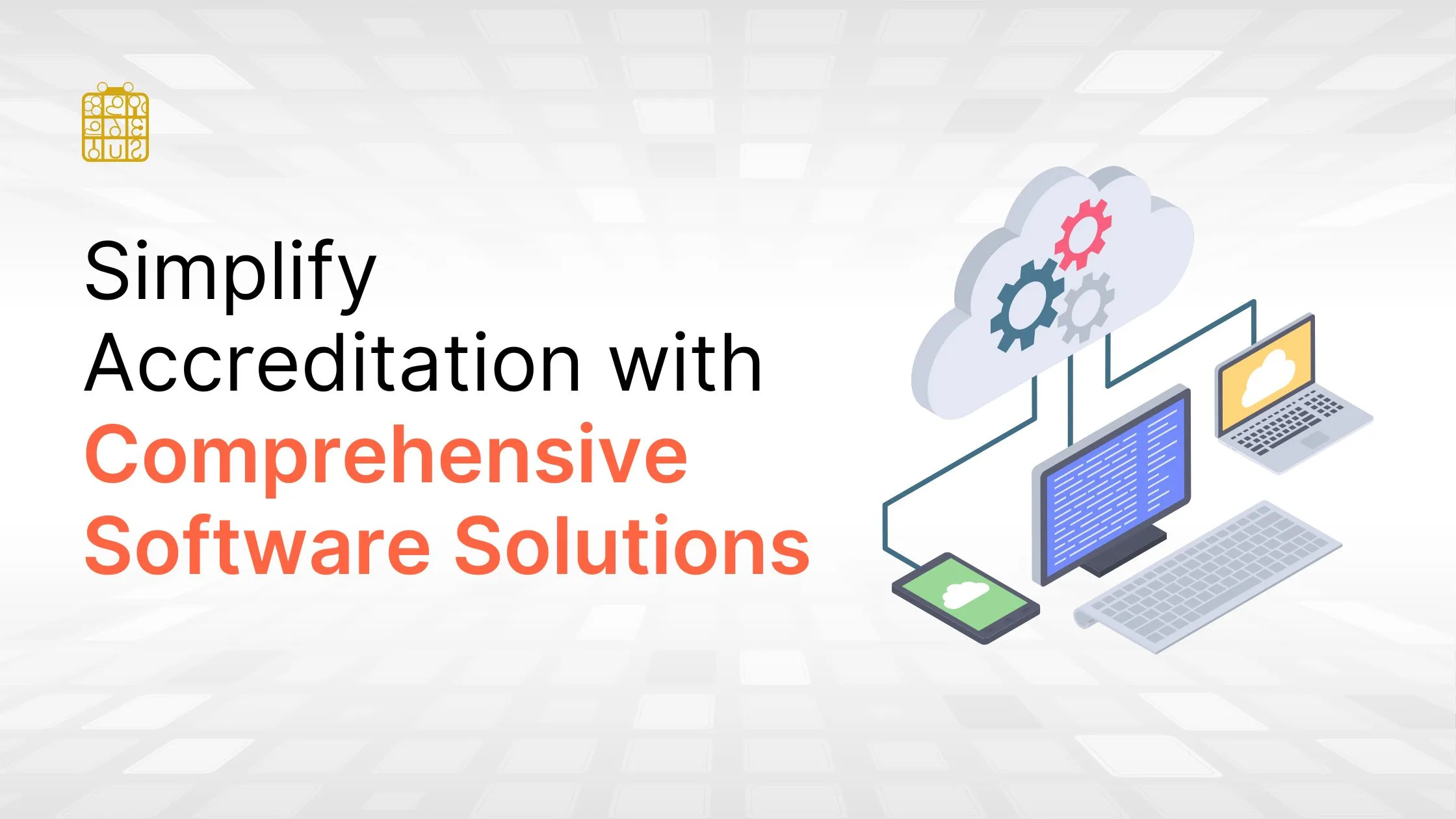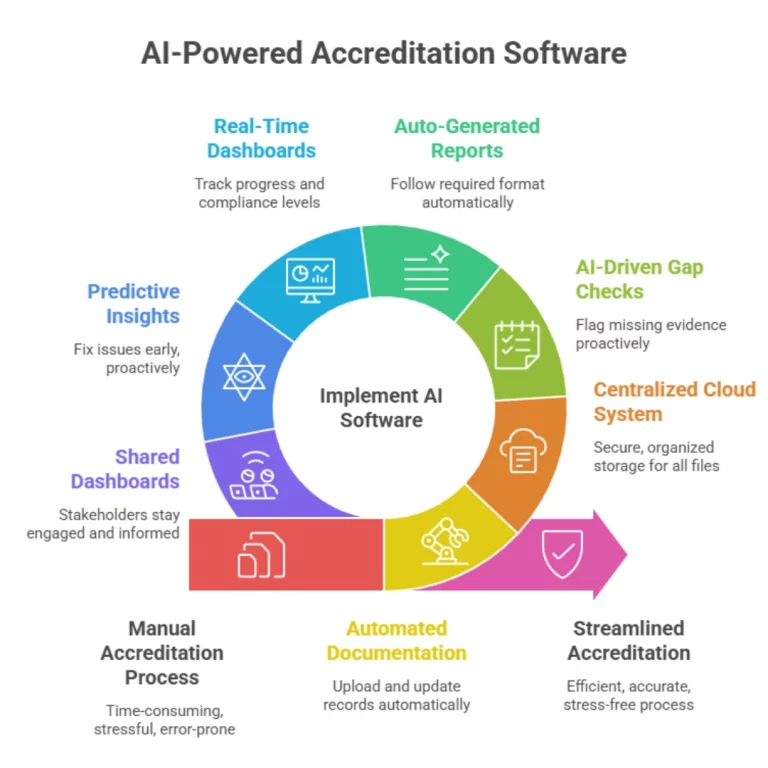Simplify Accreditation Process with AI-Powered Software Solutions
Discover how AI-Powered accreditation software can streamline data collection, compliance, and reporting, ensuring a smooth and Simplified accreditation process.
By, Kramah Author

Introduction: Rethinking the Accreditation Process
The accreditation process is the backbone of quality assurance in higher education. It proves that a program or institution meets national and global standards. For colleges and universities, accreditation builds trust, improves rankings, and opens doors to funding and collaborations. For students, it ensures their degrees are credible and recognized worldwide.
But here’s the challenge. Accreditation often means endless paperwork, last-minute data collection, and overloaded faculty members. Manual reporting and scattered files make compliance stressful and time-consuming.
This is where AI-powered accreditation software changes the game. With automation, analytics, and digital storage, institutions can move from reactive compliance to proactive quality improvement.
Why the Accreditation Process Needs Innovation
Most colleges still handle accreditation manually. Faculty and staff spend weeks pulling together files, attendance records, placements, research papers, and more. Reports are often rushed, and evidence goes missing. This leads to errors, delays, and lower chances of getting accredited.
The impact goes beyond paperwork. Faculty lose time they could spend on teaching or research. Students feel the effect when programs fail to meet accreditation standards, reducing employability and trust in their degrees. Institutions, meanwhile, risk losing credibility, rankings, and funding opportunities.
Accreditation is about continuous improvement. Institutions must stay audit-ready at all times, not just during visits. This calls for a smarter, technology-driven solution.

How AI-Powered Accreditation Software Simplifies Data Collection & Compliance
AI-powered accreditation management software makes data collection simple and stress-free. Instead of chasing files across departments, all documents are stored in a centralized cloud system.
- Automated documentation ensures that every record like faculty details, student outcomes, research, or infrastructure data is uploaded and updated on time.
- Secure, organized storage means files are easy to find, even years later, which is critical for reaccreditation cycles.
- Error reduction: Built-in checks flag missing evidence or incomplete reports before submission, saving institutions from last-minute surprises.
By turning a messy, manual process into a structured digital workflow, AI tools give colleges more control, transparency, and peace of mind.
Ensuring Standards Alignment with AI Guidance
Every accrediting body: NAAC, NBA, NIRF, AACSB, and others has its own set of standards. Meeting them manually is complex and often confusing.
AI-powered software simplifies this with built-in templates that match each framework’s requirements. Institutions don’t need to reinvent the wheel; they can plug in data directly into pre-designed formats.
The system also runs AI-driven gap checks, alerting teams about missing or weak evidence. This ensures compliance is proactive, not reactive. By closing gaps early, institutions increase their chances of audit success and higher grades.
Smarter Reporting & Self-Study Automation
One of the hardest parts of accreditation is preparing detailed Self-Study Reports (SSR/SAR). These reports demand accuracy, structure, and compliance with accreditor guidelines.
AI tools take away the burden by:
- Creating auto-generated reports that follow the required format.
- Providing real-time dashboards so administrators can track progress and compliance levels at a glance.
- Making evidence compilation simple by tagging documents and linking them to specific criteria, so reviewers get exactly what they need.
This means less manual work, faster reporting, and more confidence during external reviews.
Predictive Analytics for Gap Analysis & Quality Assurance
AI goes beyond compliance, it adds intelligence to the process. By analyzing key performance indicators (KPIs) like student outcomes, research publications, and faculty qualifications, AI highlights areas of strength and weakness.
- Gap analysis: The system flags missing data or underperforming areas before an audit.
- Predictive insights: Institutions can fix issues early, instead of waiting until the last minute.
- Continuous monitoring: Accreditation readiness is maintained year-round, making future reaccreditation cycles easier and more successful.
This shifts accreditation from a one-time event to a culture of ongoing quality assurance.
Collaboration & Stakeholder Engagement
Accreditation isn’t just the job of administrators. It involves faculty, students, employers, and regulators. Keeping everyone on the same page is often a challenge.
An accreditation management system makes collaboration easier. Faculty can upload evidence, students can share feedback, and administrators can assign tasks with clear deadlines. Stakeholders stay engaged through shared dashboards, notifications, and role-based access.
This ensures that accreditation is seen as a shared responsibility, not a one-person task.
Long-Term Benefits
Accreditation doesn’t end with approval—it must be maintained for reaccreditation. AI-powered systems support continuous improvement in accreditation by tracking progress year after year.
- Institutions don’t need to start from scratch for every cycle.
- Data is always updated and audit-ready.
- Quality initiatives become a permanent part of the culture.
This long-term view saves time, reduces stress, and strengthens institutional credibility.
User-Friendly Experience
Many educators struggle with complex portals and outdated systems. Modern accreditation management software solves this with a user-friendly interface designed for non-technical users.
- Simple dashboards make navigation easy.
- Drag-and-drop uploads reduce time spent organizing evidence.
- Mobile access ensures work can be done from anywhere.
For institutions, this means faster adoption and less training. For educators, it means more time spent on teaching, not paperwork.
Freeing Educators to Focus on Quality
At the heart of accreditation is quality education. But too often, teachers get pulled into compliance work instead of student learning.
With higher education accreditation software, AI takes care of repetitive tasks like documentation, reporting, and compliance checks. This frees faculty to focus on:
- Teaching and mentoring students
- Research and innovation
- Improving classroom outcomes
Accreditation should not feel like a burden. With smart tools, it becomes an enabler of better teaching and better learning.
Future of Accreditation
The future of accreditation is becoming more AI-driven and globally connected.
- AI in Accreditation and Compliance: Artificial intelligence will continue to simplify compliance. It will handle documentation, detect missing evidence, and give real-time guidance so institutions stay audit-ready at all times.
- NEP 2020 Accreditation Standards: India’s National Education Policy 2020 emphasizes quality, equity, and employability. Accreditation will need to prove how institutions align with these goals using data and continuous improvement.
- Global Accreditation Standards: Frameworks like the Washington Accord and the UN Sustainable Development Goals (SDGs) push institutions to think beyond local benchmarks. This global alignment ensures graduates are skilled, ethical, and ready for international opportunities.
The future points toward smarter, faster, and more outcome-based accreditation where institutions focus on impact, not paperwork.
Conclusion
Accreditation is no longer just about ticking boxes. It’s about building trust, proving quality, and preparing students for the future.
AI-powered accreditation software makes this possible by:
- Streamlining the accreditation process
- Automating compliance and reporting
- Driving continuous improvement for reaccreditation
Institutions that adopt these tools will save time, reduce stress, and strengthen their reputation. More importantly, they’ll free their educators to focus on what really matters is teaching and student success.
FAQ's:
What is accreditation software?
Accreditation software is a tool designed to streamline the accreditation process by automating data collection, documentation, compliance checks, and report generation.
How does accreditation software help with compliance?
The software maps institutional data to accreditation standards, ensuring all requirements are met and reducing the risk of non-compliance.
Can accreditation software save time for faculty and administrators?
Yes, it automates tedious tasks like documentation and report generation, allowing faculty and administrators to focus on core educational duties.
Is accreditation software user-friendly?
Most accreditation software solutions offer an intuitive interface, making it easy for faculty and staff to use without extensive technical knowledge.
What are the long-term benefits of using accreditation software?
Accreditation software helps maintain a continual record of data and documents, reducing workload in future accreditation cycles and ensuring ongoing compliance.
